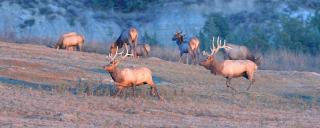 |
| Fact Sheet |
| Scientific Name |
Cervus elaphus |
| Description |
Averages 53 inches and 59 inches at the shoulder for cows and bulls, respectively. Bulls average 700 pounds (range 470-1,100 pounds); cows average 500 pounds (range 440-600 pounds). Coat reddish-brown, neck dark brown, small white tail, yellowish belly and rump patch. Antlers on males only. Main beam extending over the back, with several tines off the main beam. |
Tracks |
Elk tracks: Front track slightly larger Front–3" - 5" L, 2-1/2" - 4-1/2" W. Rear– 2-1/2" - 4-1/2" L, 2-1/2" - 4" W. Walking stride 18" - 35". |
| Habitat |
Highly adaptable and able to flourish in most habitats from dry sagebrush grasslands to forested river bottoms. |
| Food |
Elk consume a variety of plants, with a change in frequency of their favorite type from season to season. They eat more than 100 types of forbs as well as a variety of grasses and some shrub species. |
| Range |
Found on the Little Missouri National Grasslands, Killdeer Mountain area, and in Cavalier County in northeastern North Dakota. |
| Mating |
Breeding peaks in mid- to late September, with bulls tending harems of 15-20 or more cows. No permanent pair bonds. Gestation averages about 250 days. |
| Young |
One calf (rarely two) born late May to early June, and weighing about 37 pounds. Coat reddish with white spots on back. |
| Habits |
Most active at dawn and dusk. Cows usually in groups of 10 or more. Outside the breeding season, males are alone or in small bachelor groups. |
| Fun Facts |
Elk are also called wapiti, a Shawnee Indian name meaning white deer (referring to their bleached out white coat in the spring). Elk are the only species of North American deer that usually have upper canine teeth (often called bugler teeth). |


